Preface’
Science Foundation
The present volume
is an outgrowth
held at Cambridge, Mass., on September
National
purpose of the meeting was to evaluate
of the availability
opinion
tables would continue
to exist.
that
of a Conference on Mathematical
15-16, 1954, under
Tables
the auspices of the
The
in the light
of Technology.
tables
and the Massachusetts
Institute
the need for mathematical
of large scale computing machines.
in spite of the increasing use of the new machines
It was the consensus of
for
the basic need
Numerical
tables of mathematical
functions are in continual
demand by scien-
A greater variety of functions and higher accuracy of tabula-
in-
tables serve
tists and engineers.
tion are now required as a result of scientific advances and, especially,
creasing use of automatic
mainly
forpreliminarysurveys
For those without easy access to machines,
for machine operation.
such tables are, of course, indispensable.
of problems before programming
connection,
computers.
of the
latter
the
the
In
Consequently,
the Conference
version of the classical
recognized
tables of functions of Jahnke-Emde.
that
there was a pressing need for a
the project,
the National
Science Foundation
to prepare such a volume and established
modernized
ment
of Standards
mittee, with Professor Philip M. Morse of the Massachusetts
as chairman,
to advise
~course of its preparation.
of A. Erdelyi, M. C. Gray, N. Metropolis,
and J. W. Tukey.
Todd, C. B. Tompkins,
the staff of the National
to the Chairman,
In addition
requested
the National
To imple-
Bureau
an Ad Hoc Advisory Com-
of Technology
Institute
Bureau of Standards
the Committee
J. B. Rosser, H. C. Thacher,
during
the
consisted
Jr., John
The primary
aim has been to include a maximum
of useful
information
within
of a moderately
in all fields.
large volume, with particular
attention
An attempt
has been made
to cover the entire
to supplement
To carry out
the goal set forth by tbe Ad Hoc Committee,
the
in computation
work, as well as by providing
tables by including
the mathematical
to the needs of
field of special
it has been
that
numerical methods
properties
the limits
scientists
functions.
necessary
are important
which demonstrate
the use and extension of the
tables.
the direction of the late Milton
Abramowitz,
The Handbook was prepared under
Irene A. Stegun.
Its success has depended greatly upon
Their efforts together with
appreciated.
The particular
the cooperation
contributions
are acknowledged
at appropriate
places in the text.
Science Foundation
for
the preparation
of the material
the cooperation
of
of the Ad HOC
of
these and
The sponsor-
is
are greatly
and
many mathematicians.
Committee
other
ship of
gratefully
the National
recognized.
that
individuals
is hoped
It
in many cases acquaint
will
Washington,
D.C.
this volume will not only meet
the needs of all table users but
its users with new functions.
ALLEN V. ASTIN, L?imctor.
�
to
the Ninth Printing
Preface
The enthusiastic reception accorded the “Handbook of Mathematical
Functions”
is little short of unprecedented in the long history of mathe-
matical tables that began when John Napier published his tables of loga-
rithms
the first copy came
from
the Assistant Secretary of Com-
merce for Science and Technology, presented the 100,OOOth copy of the
Handbook
to the President.
Today, total distribution
the 150,000 mark at a scarcely
diminished rate.
in 1614. Only four and one-half years after
the press in 1964, Myron Tribus,
then Science Advisor
to Lee A. DuBridge,
is approaching
The success of the Handbook has not ended our interest in the subject.
On the contrary, we continue our close watch over the growing and chang-
ing world of computation and to discuss with outside experts and among
ourselves the various proposals for possible extension or supplementation
of the formulas, methods and tables that make up the Handbook.
In keeping with previous policy, a number of errors discovered since
the last printing have been corrected. Aside from
this, the mathematical
tables and accompanying text are unaltered. However, some noteworthy
changes have been made in Chapter 2: Physical Constants and Conversion
Factors, pp. 6-8. The table on page 7 has been revised to give the values
of physical constants obtained in a recent reevaluation; and pages 6 and 8
have been modified
to reflect changes in definition and nomenclature of
physical units and in the values adopted for the acceleration due to gravity
in the revised Potsdam system.
The record of continuing acceptance of the Handbook,
the praise that
has come from all quarters, and the fact that it is one of the most-quoted
scientific publications
in recent years are evidence that the hope expressed
by Dr. Astin in his Preface is being amply fulfilled.
LEWIS M. BRANSCOMB, Director
National Bureau of Standards
November 1970
�
Foreword
This volume
is the result of the cooperative
The National
Bureau
tables and has had under
of Standards
consideration,
of a compendium
like
the present one. During
the NBS Applied Mathematics
Division
long been
effort of many persons and a number
out
the
on Tables,
on May 15, 19.52, Dr. Abramo-
turning
IO years,
has
for at
a Conference
least
for such an undertaking,
support.
but
preliminary
plans
technical advice and financial
Division
since 1943 it has published
of the National Research Council
has also had an
the quarterly
editorial
journal,
supervision
“Mathe-
being
(MTAC),,
of organizations.
mathematical
production
called by
witz
indicated
of t,hat Division mentioned
the need for
The Mathematics
interest
in tables;
active
matical
Tables and Aids
exercised by a Committee
Subsequent
to
for
“that
consensus
With
Institute
using
on several
in tbe published Report
tables of various
and engineers
National Science Foundation
table production.
Massachusetts
needs
scientists
reached
forth
for example,
task of table making
also agreed
Computer,
tables
for
The Report
and that
participants,
J. H. Curtiss,
help implement
that
with
interpolation
suggested
that
the NSF contribute
the following
R. W. Hamming,
these and other
the advent
to Computation”
of the Division.
the NBS Conference
was drawn
on Tables
to the desirability
in 1952
its support
of Technology
a z-day Conference
on September
kinds.
Twenty-eight
persons
tables as well as table producers.
cpnclusions
recomlmendations,
of
of high-speed
the Conference.
cornputting
and
but definitely
did not remove
the need
of financing
the attention
of
activity
the
in
on Tables was called at the
15-16, 1954,
the
attended,
to discuss
representing
This conference
which were
set
There was general agreement,
equipment
changed
the
tables”.
It was
for the Occasional
for
of Tables
and a set of formulas
and
functions
useful
the production
to the occasional
computer”.
of such a Handbook
need is for a Handbook
“an outstanding
tables of usually encountered
techniques
the NBS undertake
and other
financial assistance.
The Conference
Committee:
P. M. Morse
(Chairman),
D. H. Lehmer, C. B. Tompkins,
recommendations.
elected,
from
M. Abramowitz,
J. W. Tukey,
its
to
undertook
Division
independent
The Bureau of Standards
to produce
National Science Foundation made funds available.
to the Mathematics
of the Bureau, which
vide
the NSF with
Committee
Tables of the Mathematics
some changes of membership,
The present
and that
judgments
as
Division
that Conferences
sometimes
recommendations
the Committee
reconstituted
is evidence
became
volume
their
was
on grants
ffor the work,
on Revision
of the National Research Council.
the Committee which
is signing
can sometimes
get acted on.
the recommended
To provide
carried out
the work,
tables and the
technical guidance
and to pro-
the Conference
of Mathematical
This, after
this Foreword.
reach conclusions
V
,/”
�
VI
FOREWORD
Active work was started at the Bureau
for the various chapters, and
of Dr. Abramowitz.
the general direction
required
in 1956. The overall plan,
the enthusiasm
Since his untimely
of Irene A. Stegun.
the selection
task
the effort has
the
of
have had many discussions about
Though many details have had t’o be argued out as they
the same as were
death,
The workers at
of the volume have remained
the Committee
to begin
the
and
the members
style and layout.
the basic specifications
of authors
were contributions
continued
under
Bureau
content,
came up,
outlined
by
of the task carried out by the staff of the NBS Computing
the Massachusetts
Institute
The Committee
wishes here to register
in planning,
quality
expert collaborators
ciation of the willingness with which
the plans. We hope this resulting
memorial
We regret he did not live
the vision and
industry
to
to see its publication.
its commendation
of Technology Conference of 1954.
of the magnitude
and
Section and their
these Tables, and its appre-
into
volume will be judged by its users to be a worthy
its various suggestions were incorporated
and editing
collecting
of its chief architect, Milton
Abramowitz.
P. M. MORSE, Chairman.
A. ERD~LYI
M. C. GRAY
N. C. METROPOLIS
J. B. ROSSER
H. C. THACHER.
JOHN TODD
‘C. B. TOMPKINS
J. W. TUKEY.
Jr.
�
Handbook
of Mathematical
Functions
with
Formulas,
Graphs,
and Mathematical
Tables
Edited by Milton Abramowitz
and Irene A. Stegun
1.
Introduction
The present Handbook
scientific
functions
problems.
the
volume ext,ends
by E. Jahnke
to workers
during
provide
hensive and self-contained
matical
neering
Funct.ions
invaluable
editions’
present
by giving more
numerical
of mathematical
functions.
also been increased.
The classification
the chapters
of
that
of An
A. Fletcher,
In general,
graphs,
for automatic
principal mathematical
lated
the chapters
or
computers,
polynomial
functions,
investigators
that arise
The well-known
with
summary
in physical
has been designed
to
a compre-
of the mathe-
and engi-
Tables
of
and F. Emde has been
in its many
The
of these authors
accurate
larger collections
tabulated
fields
half-century.
and more
the
of
in these
past
the work
tables, and by giving
extensive
properties
The number of functions
covered has
of functions
this Handbook
of Mathematical
in
Index
J. C. P. Miller,
and organization
is similar
Tables
to
by
and L. Rosenhead.
contain numerical
rational
approximations
tables,
properties
and statements
of
the
tabu-
those of computa-
the
of
particularly
to illustrate
importance.
tional
are given
the computation
also
range.
outside
their
each chapter
there
books and papers
properties
matical
found.
Also
more
sive
tioned
tables
Council
(formerly
to Computation).
above,
is
important
lists of
listed
to be found
quarterly
Mathematical
Many
of function
At
numerical
the use of the
examples
tables and
lie
values which
text
in
giving
proofs of the mathe-
in the chapter may be
the
the
is a short bibliography
in which
stated
in the bibliographies
the end of
are
numerical
tables.
tables are given
in
and current
in
information
the National
Mathematics
the
Comprehen-
Index men-
on new
Research
of Computation
Tables and Other Aids
notations
commonly
Higher
The ma.thematical
are
those
particularly
adopted
Transcendental
used in this Hand-
in standard
book
Func-
texts,
1-3, by A. ErdBlyi, W. Magnus,
tions, Volumes
F. Oberhettinger and F. G. Tricomi
(McGraw-
Hill, 1953-55). Some alternative notations have
also been listed. The introduction of new symbols
has been kept
to a minimum, and an effort has
been made to avoid the use of conflicting notation.
2. Accuracy
of the Tables
The number of significant
figures given in each
table has depended to some extent on the number
available in existing tabulations.
There has been
no attempt
the
throughout
to make it uniform
Handbook, which would have been a costly and
laborious undertaking.
In most tables at least
five significant
figures have been provided, and
the tabular’ intervals have generally been chosen
to ensure that linear interpolation will yield. four-
or five-figure accuracy, which suffices in most
physical applications. Users requiring higher
recent,
in 1960 by McGraw-Hill,
was
1 The most
2 The second edition, with L. J. Comrie added as co-author, was published
and Scientific Com-
the sixth, with F. Loesch added as cc-author,
U.S.A., and Teubner, Germany.
published
in two volumes
puting Service Ltd., Great Britain.
in 1962 by Addison-Wesley,
U.S.A.,
precision in their
by use of higher-order
described below.
interpolates may obtain
them
interpolation procedures,
In certain
tables many-figured
function values
are given at irregular
in the argument.
An example is provided by Table 9.4. The pur-
pose of these tables is to furnish “key values” for
the checking of programs for automatic computers;
no question of interpolation arises.
intervals
The maximum end-figure error, or “tolerance”
is 6/& of 1 unit
in the tables in this Handbook
everywhere
func-
tions, and 1 unit in the case of the higher functions
except in a few cases where it has been permitted
to rise to 2 units.
in the case of the elementary
IX /-
�
.
X
INTRODUCTION
3.
Auxiliary
Functions
and Arguments
One of the objects of this Handbook
is to pro-
tables or computing methods which enable
functions over
tabulated
the
ranges of real values of their parameters.
to achieve
this object,
functions
the original
and auxiliary
arguments
An example will make
functions
to remove
at
frequent use has
the
their
to co e with
t fi e pro-
vide
the user to evaluate
complete
In order
been made of auxiliary
infinite
singularities,
infinite
cedure clear.
part of
ranges.
The exponential
integral
of positive
argument
is given by
recludes direct
unctions Ei(x)-In
P
however,
in
function;
this
inter-
x
are well-
region.
the latter
higher
function
to nine
slightly
The
tabulated
For +/(x1-~0>
and jP
instance, we have
the required
interpolate.
In
the present
jo=.89717
4302
ji=.89823
7113
p=.527
The most convenient way to evaluate
on a desk calculating machine
in turn on the keyboard,
plications
check
is
reading unity. We obtain
the formula
is.to set o and ji
and carry out t d e multi-
a partial
dial
by
then provided
and p cumulatively;
the multiplier
by
l-p
j.6z,E.‘;9;72;&39717
4302)+.527(.89823
7113)
it
Since
is known
of 3 X 10 -6 in the linear
result
this answer
.89773. The maximum
possible error
is composed of the error committed
there
is a possible error
formula, we round off this
in
that
to
�
INTRODUCTION
XI
is,
that
by
the
3 X lo-‘,
roundingJ
last
and so certainly
formula.
this example,
is the 5-point one, given by
.4403X 10m5, plus
cannot exceed .8X lo-‘.
the
(2) Lagrange’s
formula
relevant
f=A-,(p)f_z+A-,(p)f-1+Ao(p>fo+A,(p)fi
In
the range p=O(.Ol)l.
for p=.52,
Tables of the coefficients An(p) are given
25
for
formula
in each evaluation we accumulate
multiplier
now have
register since
the following
their sum
subtable.
.53 and
.54 in
We evaluate
+A&)fa
in chapter
the
Again,
in the
is unity. We
turn.
the An(p)
x
7.952
7.953
7.954
m=&(x)
9757
.89772
.89774
0379
.89775
0999
10622
10620
-2
in the
third and fourth columns are
first and second differences of the values of
(see below) ; the smallness of the second
The numbers
the
xezEl(x)
difference provides a check on the three
tions.
linear
is now obtained
required
:
interpolation
interpola-
value
The
by
fn=.3(.89772
9757)+.7(.89774
0379)
= 239773 7192.
In cases where the correct order of the Lagrange
polynomial
interpolations
polynomials
check on their adequacy.
is not known, one of the prelimina
may have
to be performed wit
T
of two or more different orders as a
(3) Aitken’s method of iterative
for carrying
The scheme
tion.
in the present example
linear
out
is as follows:
interpola-
this process
.;
1
2
3
4
5
&
7.9
8.1
7.8
8.2
7.7
:
Yn=ze”G@)
7113
89823
89717
4302
7888
89927
8737
: 89608
7306
. 90029
. 89497
9666
Yo. I
89773
:89774
44034
48264
2 90220
4 98773
2 35221
Yo. 1, (I
Yo, 1.2. I
Yo.1.a.s.n
.89773
71499
2394
1216
2706
. 89773
71938
ii
89773
71930
30
X,-X
.0473
0527
. 1473
1527
. 2473
2527
-.
-.
-.
Here
yo,n=-
1
Yo
x.--20 Yn
20-x
x,-x
Yo.1
Yo.
1
Yo.1
,n=- G--z1 l/O.”
. .
., m--l.m.n--
1.
x,-x
x,-x
1
~n-%n
.
l/0.1.
Yo.1. .
.
.
., n-1.98
-, m-1.n
x,-x
x,-x
1
and x~--5 are used as
on a
the cross-product
If
the quantities
when
Z.-X
forming
their accumulation
multipliers
desk machine,
in the multiplier
at that stage. An extra decimal place
intermediate
carried
interpolates
of rounding
guard against accumulation
is the divisor
register
(~~-2)
the
in
-(x,-x)
to be used
is usually
to safe-
errors.
in which
to some extent, but
the tabular
rate of convergence and at
accumulation
this example, with
of rounding
the
the given argument,
tabular
to
the nearest of the remaining
values are used
to achieve
the
the same
errors,
tabular
then
argu-
The order
is immaterial
maximum
time minimize
we begin, as in
argument
take
ments, and so on.
of
The number
nearest
values
required
emerges naturally
tabular
achieve a given precision
the course of the iterations.
example six values were used, even though
known
in advance
extra row confirms
check.
a valuable
to
in
in the present
it was
that
five would suffice. The
the convergence and provides
Thus
(4) Difference
difference notation
formulas. We use
the central
(chapter 25),
S2fl
safz
wa
Here
Sf1l2=f1-f0, 8f3/a=fz-f1, . . . ,,
a2/1=sf3ia-afiia=fa-2fi+fo
~af3~~=~aja-~aj~=fa-3j2+3fi-k
8'fa=~aj~fsla-6~3~2=f4-~f~+~ja-4f~+fo
and so on.
In
table
is as follows,
the present example
difference
written
function,
high differences provides a check on the function
values
the relevant part of the
the differences being
lace of the
The sma ness of the
in units of the
as is customary.
last decimal
B
xe=El(x)
7:9
8.0
.89717
. 89823
4302
7113
SY
2754
2036
-2
-2
S4f
-34
-39
Applying,
formula
for example, Everett’s
interpolation
j~=(l-P)fo+E2(P)~*jo+E4(P)~4jo+
.
+Pfl+F2(P)~afl+F4(P)~4fl+
.
.
.
.
* *
the numerical
and
tion
from Table 25.1, we find
takin
toe flf cients Es(p), E4
!l
t at
values of the interpola-
and F,(p)
), F,(p)
,,/
�
INTRODUCTION
XII
10Qf.6,=
.473(89717
+
.527(89823
7193.
= 89773
4302)
+
7113)
.061196(2
+
.063439(2
2754)
-
2036)
.012(34)
-
.012(39)
We may
formula
shows
is approximately
notice
that
in passing
that
in a linear
Everett’s
interpolate
the error
mPwfo+
F2(P)wl= m(P) + ~2(P)lk?f0+wJ
Since the maximum
range O
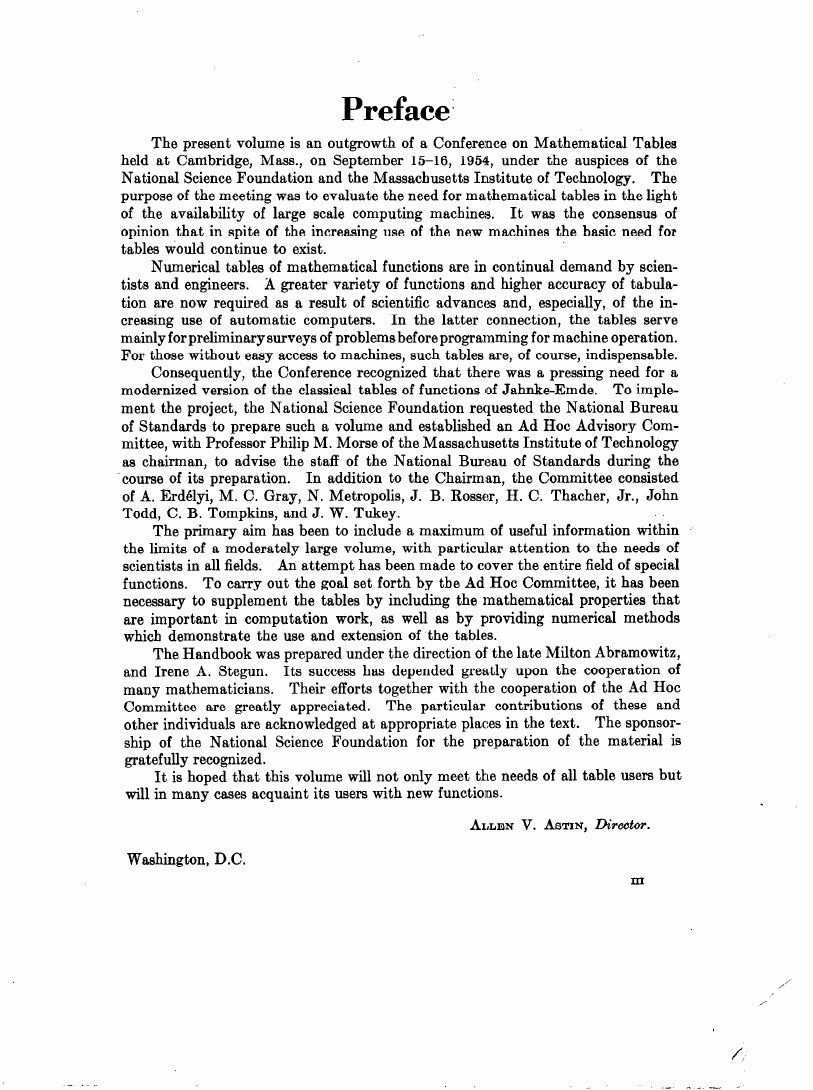
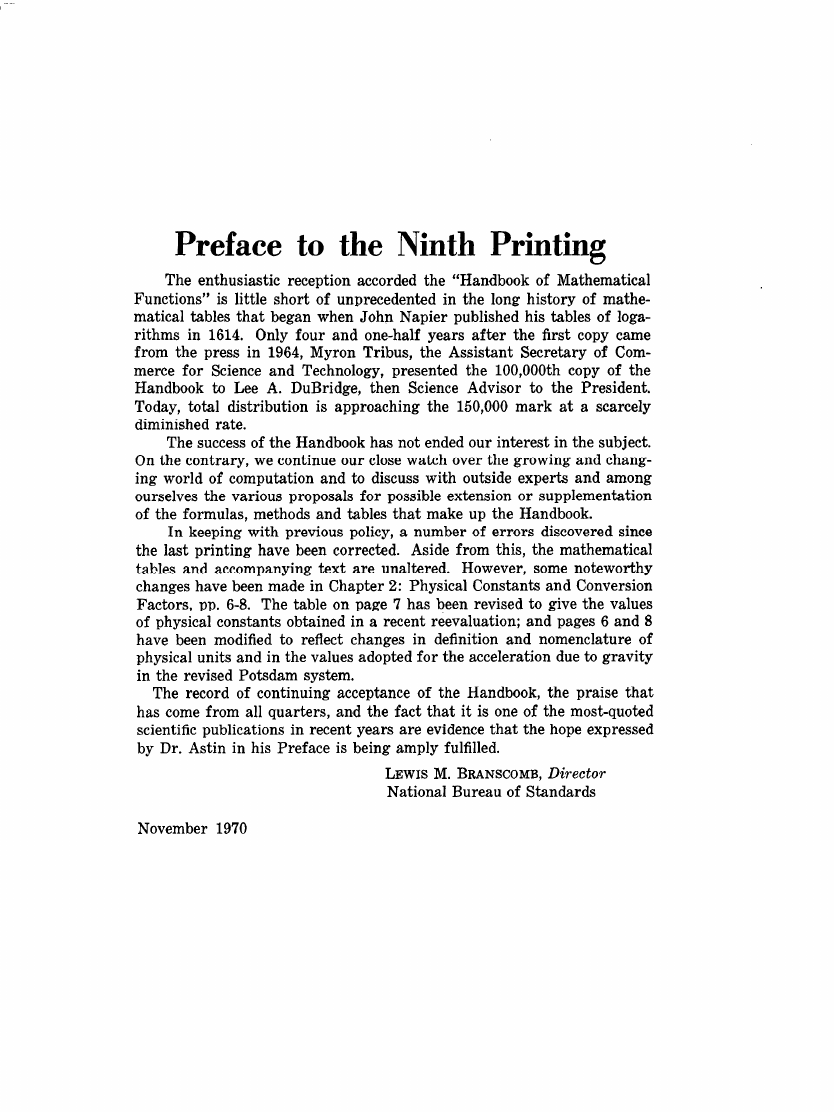
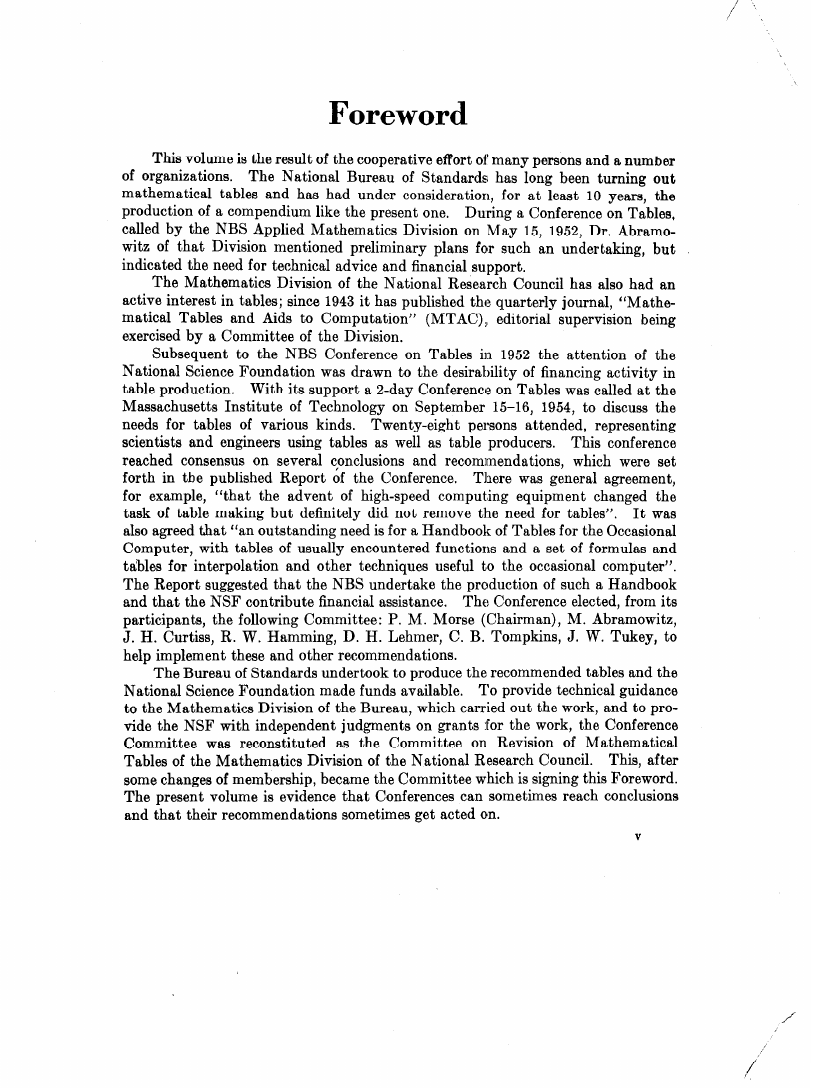
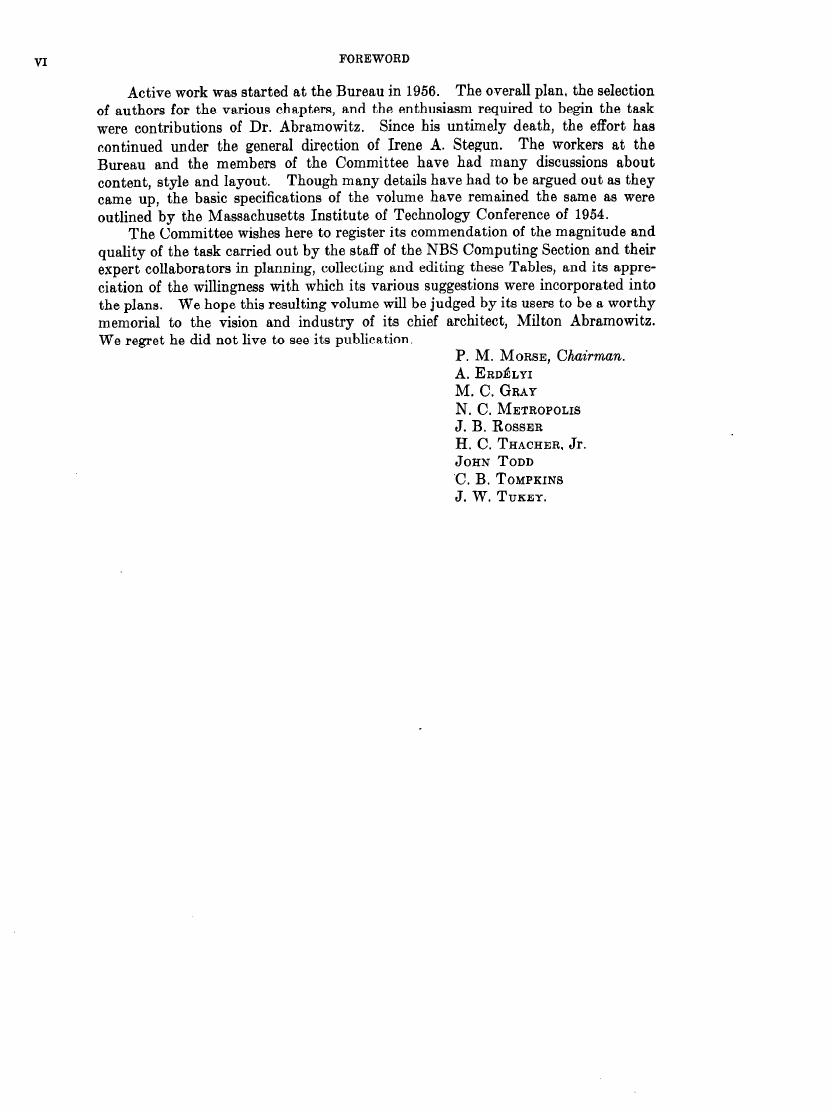
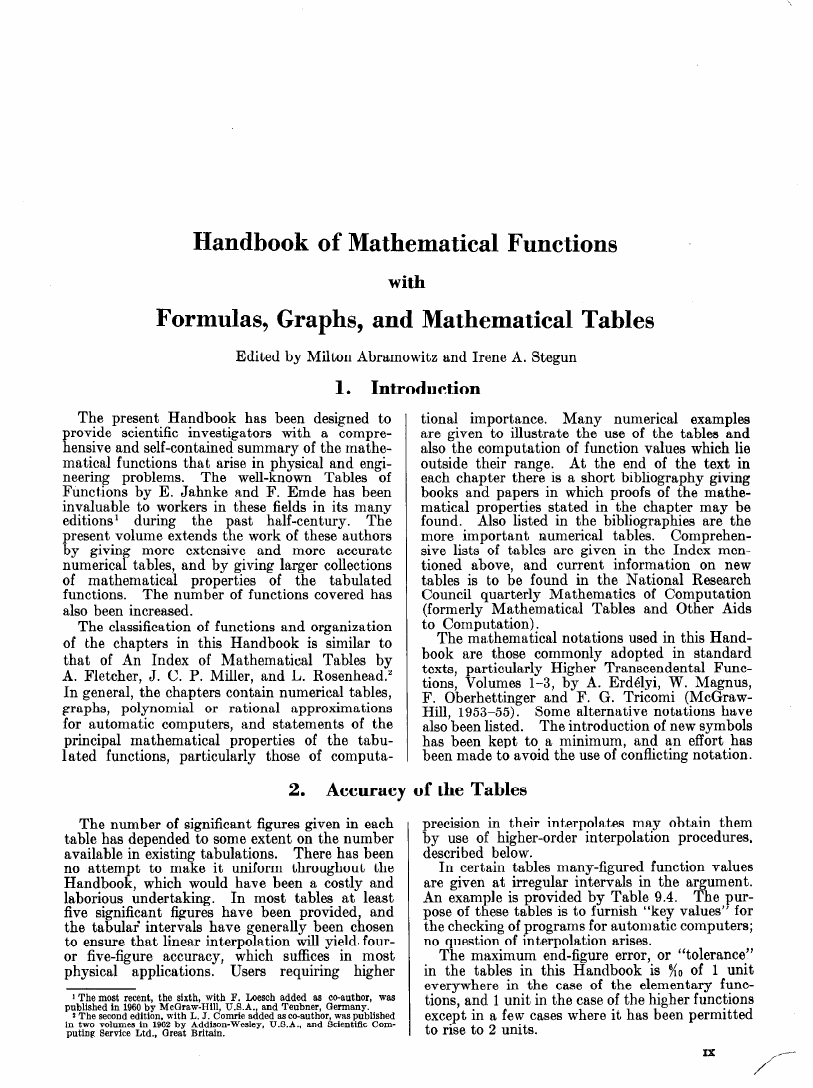

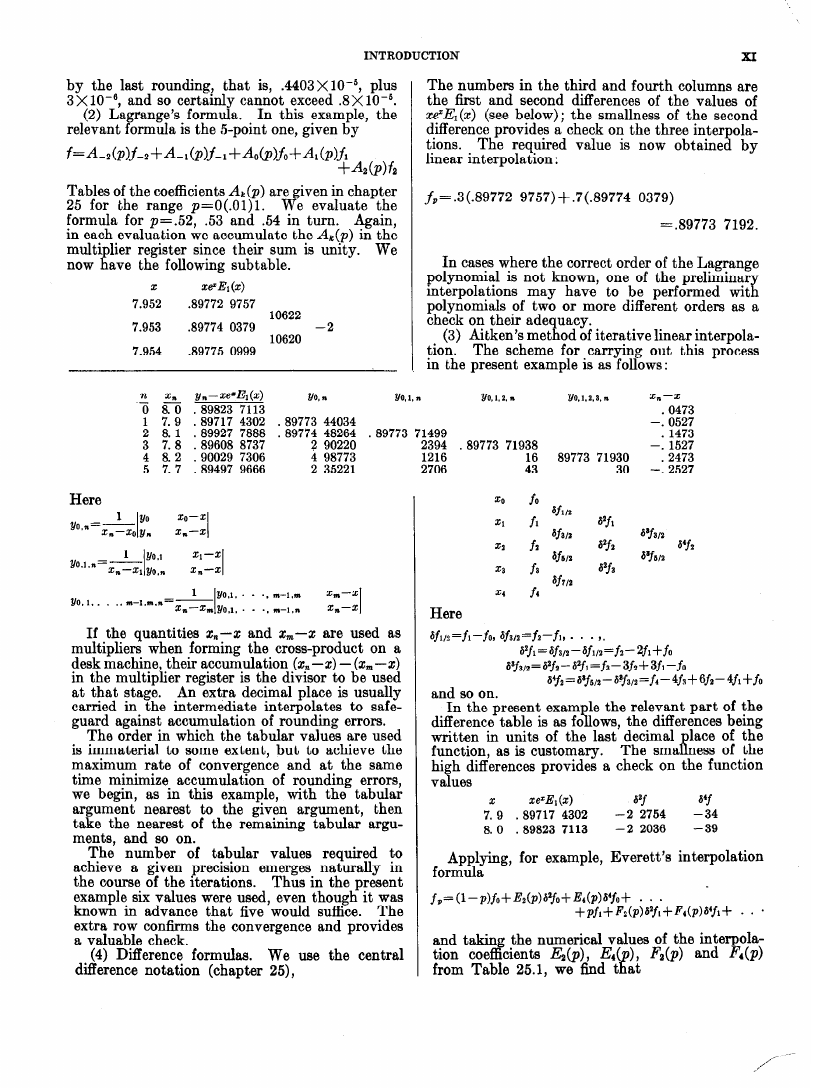
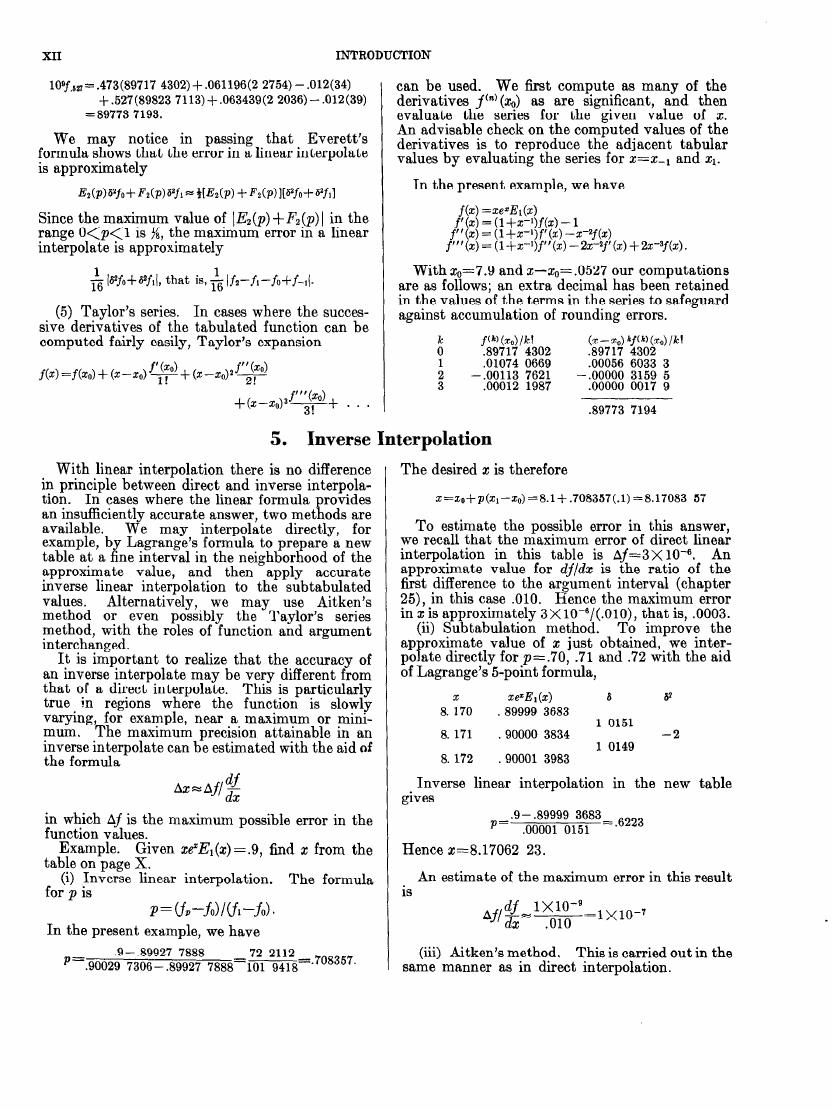








 2023年江西萍乡中考道德与法治真题及答案.doc
2023年江西萍乡中考道德与法治真题及答案.doc 2012年重庆南川中考生物真题及答案.doc
2012年重庆南川中考生物真题及答案.doc 2013年江西师范大学地理学综合及文艺理论基础考研真题.doc
2013年江西师范大学地理学综合及文艺理论基础考研真题.doc 2020年四川甘孜小升初语文真题及答案I卷.doc
2020年四川甘孜小升初语文真题及答案I卷.doc 2020年注册岩土工程师专业基础考试真题及答案.doc
2020年注册岩土工程师专业基础考试真题及答案.doc 2023-2024学年福建省厦门市九年级上学期数学月考试题及答案.doc
2023-2024学年福建省厦门市九年级上学期数学月考试题及答案.doc 2021-2022学年辽宁省沈阳市大东区九年级上学期语文期末试题及答案.doc
2021-2022学年辽宁省沈阳市大东区九年级上学期语文期末试题及答案.doc 2022-2023学年北京东城区初三第一学期物理期末试卷及答案.doc
2022-2023学年北京东城区初三第一学期物理期末试卷及答案.doc 2018上半年江西教师资格初中地理学科知识与教学能力真题及答案.doc
2018上半年江西教师资格初中地理学科知识与教学能力真题及答案.doc 2012年河北国家公务员申论考试真题及答案-省级.doc
2012年河北国家公务员申论考试真题及答案-省级.doc 2020-2021学年江苏省扬州市江都区邵樊片九年级上学期数学第一次质量检测试题及答案.doc
2020-2021学年江苏省扬州市江都区邵樊片九年级上学期数学第一次质量检测试题及答案.doc 2022下半年黑龙江教师资格证中学综合素质真题及答案.doc
2022下半年黑龙江教师资格证中学综合素质真题及答案.doc